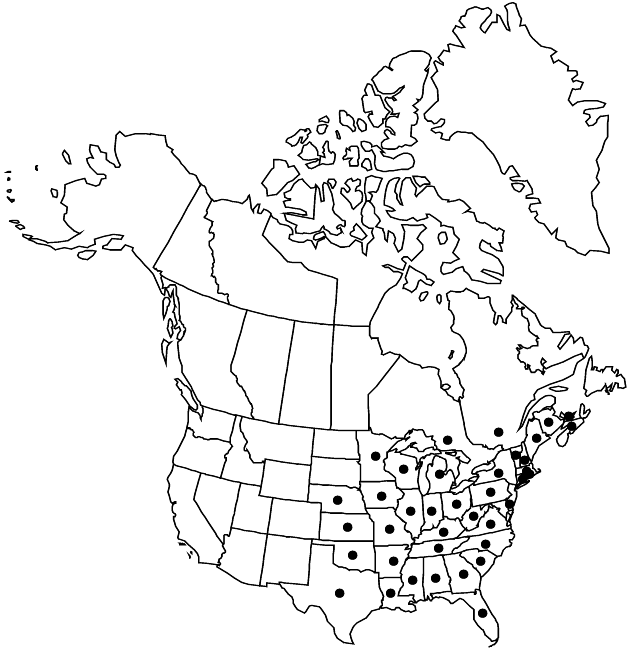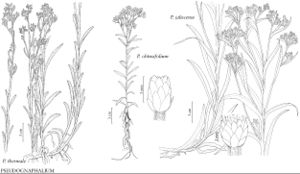Difference between revisions of "Pseudognaphalium obtusifolium"
Bot. J. Linn. Soc. 82: 205. 1981.
FNA>Volume Importer |
imported>Volume Importer |
||
| (2 intermediate revisions by 2 users not shown) | |||
| Line 8: | Line 8: | ||
}} | }} | ||
|common_names=Eastern rabbit-tobacco;gnaphale à feuilles obtuses | |common_names=Eastern rabbit-tobacco;gnaphale à feuilles obtuses | ||
| + | |special_status={{Treatment/ID/Special_status | ||
| + | |code=F | ||
| + | |label=Illustrated | ||
| + | }}{{Treatment/ID/Special_status | ||
| + | |code=E | ||
| + | |label=Endemic | ||
| + | }} | ||
|basionyms={{Treatment/ID/Basionym | |basionyms={{Treatment/ID/Basionym | ||
|name=Gnaphalium obtusifolium | |name=Gnaphalium obtusifolium | ||
| Line 35: | Line 42: | ||
|distribution=N.B.;N.S.;Ont.;P.E.I.;Que.;Ala.;Ark.;Conn.;Del.;Fla.;Ga.;Ill.;Ind.;Iowa;Kans.;Ky.;La.;Maine;Mass.;Mich.;Minn.;Miss.;Mo.;Nebr.;N.H.;N.Y.;N.C.;Ohio;Okla.;Pa.;R.I.;S.C.;Tenn.;Tex.;Vt.;Va.;W.Va.;Wis. | |distribution=N.B.;N.S.;Ont.;P.E.I.;Que.;Ala.;Ark.;Conn.;Del.;Fla.;Ga.;Ill.;Ind.;Iowa;Kans.;Ky.;La.;Maine;Mass.;Mich.;Minn.;Miss.;Mo.;Nebr.;N.H.;N.Y.;N.C.;Ohio;Okla.;Pa.;R.I.;S.C.;Tenn.;Tex.;Vt.;Va.;W.Va.;Wis. | ||
|tables= | |tables= | ||
| − | |references= | + | |references={{Treatment/Reference |
| + | |id=nesom2001a | ||
| + | |text=Nesom, G. L. 2001c. Notes on variation in Pseudognaphalium obtusifolium (Asteraceae: Gnaphalieae). Sida 19: 615–619. | ||
| + | }} | ||
}}<!-- | }}<!-- | ||
| Line 52: | Line 62: | ||
|elevation=5–200 m | |elevation=5–200 m | ||
|distribution=N.B.;N.S.;Ont.;P.E.I.;Que.;Ala.;Ark.;Conn.;Del.;Fla.;Ga.;Ill.;Ind.;Iowa;Kans.;Ky.;La.;Maine;Mass.;Mich.;Minn.;Miss.;Mo.;Nebr.;N.H.;N.Y.;N.C.;Ohio;Okla.;Pa.;R.I.;S.C.;Tenn.;Tex.;Vt.;Va.;W.Va.;Wis. | |distribution=N.B.;N.S.;Ont.;P.E.I.;Que.;Ala.;Ark.;Conn.;Del.;Fla.;Ga.;Ill.;Ind.;Iowa;Kans.;Ky.;La.;Maine;Mass.;Mich.;Minn.;Miss.;Mo.;Nebr.;N.H.;N.Y.;N.C.;Ohio;Okla.;Pa.;R.I.;S.C.;Tenn.;Tex.;Vt.;Va.;W.Va.;Wis. | ||
| − | |reference= | + | |reference=nesom2001a |
|publication title=Bot. J. Linn. Soc. | |publication title=Bot. J. Linn. Soc. | ||
|publication year=1981 | |publication year=1981 | ||
| − | |special status= | + | |special status=Illustrated;Endemic |
| − | |source xml=https:// | + | |source xml=https://bitbucket.org/aafc-mbb/fna-data-curation/src/2e0870ddd59836b60bcf96646a41e87ea5a5943a/coarse_grained_fna_xml/V19-20-21/V19_686.xml |
|tribe=Asteraceae tribe Gnaphalieae | |tribe=Asteraceae tribe Gnaphalieae | ||
|genus=Pseudognaphalium | |genus=Pseudognaphalium | ||
Latest revision as of 19:54, 5 November 2020
Annuals or winter annuals (sometimes faintly fragrant), (10–)30–100 cm; taprooted. Stems white-tomentose, sometimes lightly so, usually not glandular, rarely glandular near bases. Leaf blades linear-lanceolate to elliptic or oblanceolate, 2.5–10 cm × 2–10 mm (relatively even-sized), bases not clasping, not decurrent, margins flat, faces bicolor, abaxial white-tomentose, adaxial green, usually glabrous or slightly glandular, sometimes with persistent light tomentum. Heads in corymbiform (sometimes rounded to elongate) arrays. Involucres broadly campanulate, 5–7 mm. Phyllaries in 4–6 series, white (opaque, usually shiny, sometimes dull), ovate to ovate-oblong, glabrous or tomentose (bases). Pistillate florets 38–96. Bisexual florets 4–8(–11). Cypselae ridged, smooth.
Phenology: Flowering Aug–Oct.
Habitat: Open sites, often disturbed, roadsides, fields, pastures, open woods, in various soils, most abundantly in sand
Elevation: 5–200 m
Distribution

N.B., N.S., Ont., P.E.I., Que., Ala., Ark., Conn., Del., Fla., Ga., Ill., Ind., Iowa, Kans., Ky., La., Maine, Mass., Mich., Minn., Miss., Mo., Nebr., N.H., N.Y., N.C., Ohio, Okla., Pa., R.I., S.C., Tenn., Tex., Vt., Va., W.Va., Wis.
